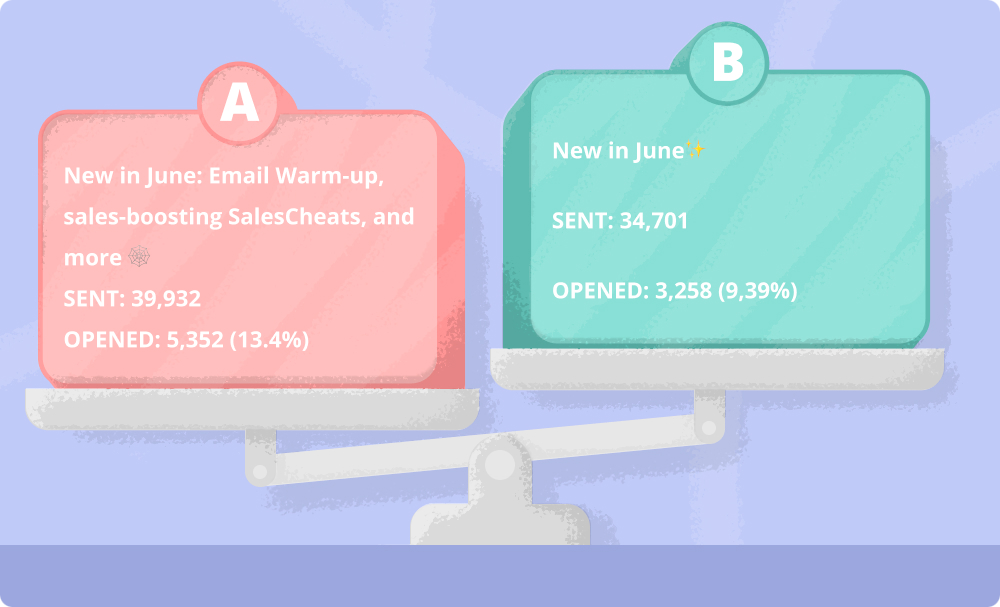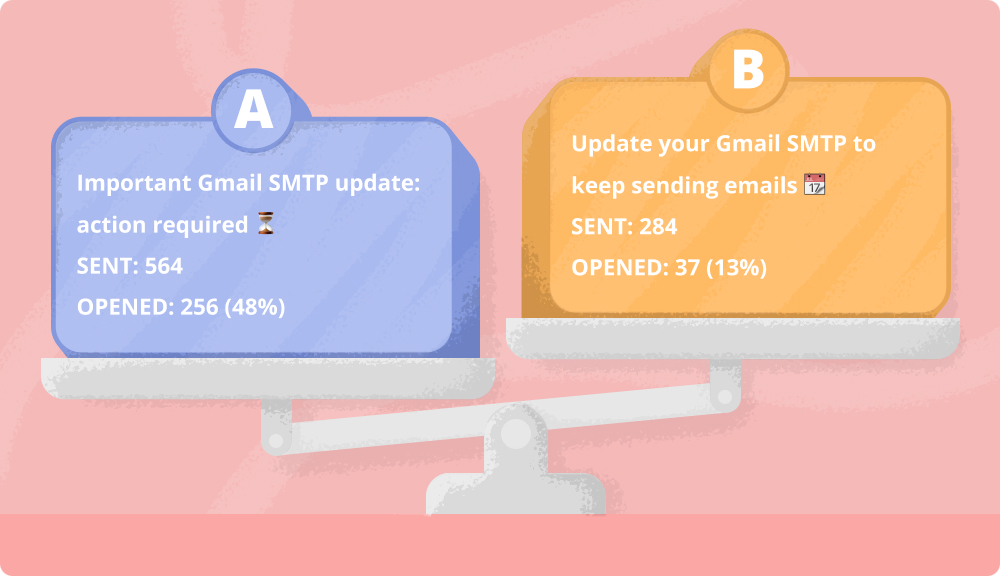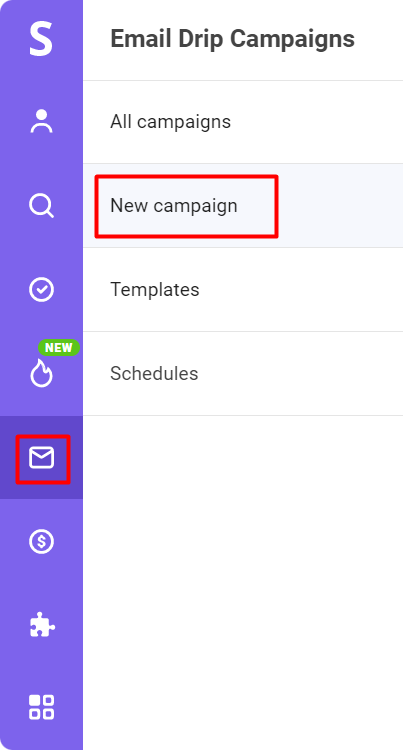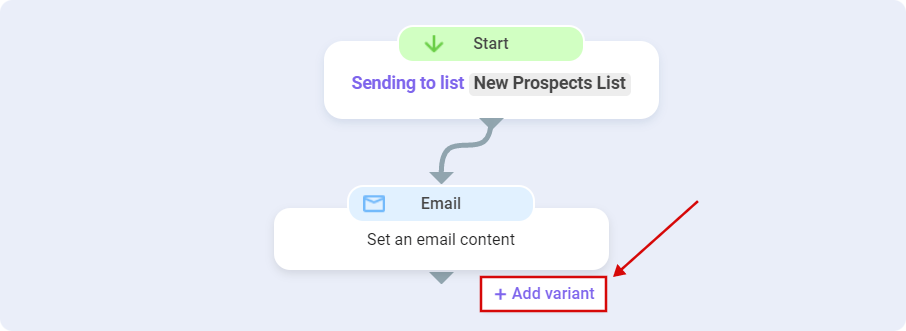Subject lines are like diamonds that need to be cut.
They’re the first thing your recipients see, and they can make or break your open, click-through, and conversion rates. In fact, a recent study showed that nearly 64% of recipients open emails based on the subject line alone.
Then why are they most commonly overlooked?
Because sometimes, marketing and sales teams think they know better what will catch the eye of their prospects. Is it worth risking budgets by trusting your taste and intuition regarding the subject line choice? The quick answer is NO. They often fail, and this is something we know from our experience, too.
People perceive things, including your email messages, so differently that you’d better be sure you choose the right message — the one most of your audience would like and not the one you like.
If you don’t A/B test your subject lines, you’ll never know whether you send the best click-worthy message to your contacts. And if you don’t send your best possible message, you won’t get the results you want from your email campaigns.

In this blog post, we’ll show you how to test your email subject lines to find the ones that get the most opens and, ultimately, bring more traffic, conversions, and revenue.
Outline:
But first, what exactly does A/B testing entail?
A/B testing (or split testing) ensures your email campaigns are as effective as possible. Simply put, it’s the process of comparing two versions of something (for example, your email subject lines) to see which one performs better.
Perhaps you want to rebrand, change your approach to your leads when nurturing them, or maybe test a new idea for your cold email marketing campaign, which might seem crazy at first sight. This is where A/B testing comes in handy.
Using A/B testing, you can determine which email variations prompt more people to open your emails, click through to your website, or make a purchase. You can also use it to test the effectiveness of different calls to action, email length, personalization, and more.
What to test in your subject lines?
If your subscribers don’t like what they see in their inboxes, they won’t bother reading further. Take your time to craft attention-grabbing, highly responsive email subject lines. You can use tips from our previous blog post featuring psychological hooks that make people want to open your email.
You’ll need to create two versions of the same headline (A and B) and send them out to random recipient segments to see which resonates best with your audience. You can never be too sure about what will get your recipients to open your messages until you test it.
But what are the criteria for testing?
Here are some of our tried-and-true testing parameters, but don’t limit yourself: everything is testable!
1. Intrigue
We’ve all seen those highly creative email subject lines that aim to arouse people’s curiosity.
- Don’t open ’til after dessert
- We don’t usually do this
- We’ve been waiting for MONTHS to announce this…
I’m pretty sure you, too, have got something similar in your mailbox at least once. And you might have read articles claiming that no one can resist creatively intriguing subject lines because it’s human nature to be curious.
Well, maybe yes, maybe not. There are also marketing pundits who disagree, assuming that fun and creativity aren’t always the key to success. Sometimes, keeping it simple is the best way to go.
Marketers at Snov.io have recently tested subject lines according to the Intrigue vs. No intrigue parameter. What will bring more email opens: if you say directly what the email will be about (Variant A) or keep the intrigue (Variant B)?

Maybe people are more likely to open an email when they see that the message inside will be about something that interests them?
Well, in our case, the intrigue didn’t work :-). Still, every email campaign is unique, and yours may show a different result.
2. Sense of urgency
Studies show that incorporating a sense of urgency and exclusivity in an email subject line can boost the email open rate by 22%. And we here at Snov.io fully agree!
Here’s another A/B test from our marketing team. Will creating a sense of urgency (Variant A) make people open an email, or will they react better to a kind reminder (Variant B)?

There’s also another reason adding a sense of urgency does wonders. Using urgency-inducing words and phrases such as Today only, Expires, Fast, Instant access, Last chance, or Now or never promise your recipients the right-now rewards that are only a click away. It would be a big mistake if marketers didn’t use it to boost their email open rates.
3. Subject line length
The shorter, the better. But sometimes, it’s tough to be laconic and put everything you want to say in a concise headline.
- Collect CEO emails fast
- Find CEO email addresses in a heartbeat
You can try different lengths of your subject lines, but remember that 82% of marketers send emails with subject lines that don’t exceed 60 characters with spaces (6-7 words). Otherwise, such headlines won’t be visible on mobile gadgets.
Moreover, a recent study found that 7-word subject lines are the best in terms of overall audience engagement.

Still, this doesn’t mean you can’t experiment with longer headlines, as some prospects might be curious by the sight of a cut-off subject line and be more likely to open the email and discover what goes further.
4. Subject line tone
Does a more playful tone result in more email opens, or does a more serious tone work better? Should you include some wit and humor in your email subject line, or should you avoid it?
Striking the perfect balance between serious and playful can be tricky – you don’t want your email to come across as boring, but you also don’t want it overshadowed by a funny subject line.
- A disruptive FinTech tool to simplify your accounting
- A FinTech tool to cheer up your accountant
On the one hand, a playful tone could result in more email opens. After all, who doesn’t like a good laugh? But on the other hand, you don’t want to come across as too casual or unprofessional. So what’s the right move?
The answer is simple: it depends on your target audience. For the young audience, a playful tone is definitely the way to go. You might just have a knack for writing catchy subject lines that make people smile. But if you’re targeting an older and more serious demographic, you’ll want to avoid any jokes or references that might fly over their heads.
Also, a more serious tone might work better if you’re trying to sell a product or service, while a more playful tone might work better for announcing a sale or new arrivals.
5. Personalization
As practice shows, the open rate is much higher with the personalized subject line. The name of your respondent included in the headline can increase your chances of getting a response by a whopping 30.5%.
- Attn.: [Name], Marketing Director at [Company]
- Attn.: Marketing Director at [Company]
Meanwhile, personalization doesn’t necessarily imply only adding your recipient’s name to the email subject line. You can also try adding their company name, role/position, or a special business event/conference based on their location.
6. Power words
Sometimes one word is worth a million. When added, changed, or removed in the subject line, this single word can alter how your subscribers respond to your emails. A certain power word can be a secret ingredient that adds emotion and ramps up the message you want to convey in your subject line.
- Try out a lead-generation software for collecting targeted leads
- A lead-generation software for collecting extremely targeted leads
With the power words of persuasion, you can make your recipients curious (unlock, eye-opening, little-known), appeal to their sense of vanity (unbeaten, brassy, awe-inspiring), or even evoke fear of losing something important (mistake, risky, warning).
However, you’ll never know if your audience perceives the power words in the context you offer until you A/B test your subject lines. You might crack the code to the perfect subject line with a power word or without any.
7. Punctuation
When it comes to punctuation, it’s best to experiment with the full stop, question mark, or no punctuation at all.
- A simple CRM system your business needs is here.
- A simple CRM system for your business needs? It’s here
- A simple CRM system your business needs is here
Some studies show that subject lines phrased as questions perform better than similar subject lines created as statements. However, it all depends on the audience. If your audience is sales and marketing people, they might have noticed that subject lines with a question mark are more commonly marketing emails and won’t bother to open them.
As for the exclamation marks (especially using too many of them!!!!), it’s recommended to avoid them because this type of punctuation might make your email appear spammy. It’s a clear trigger for spam filters, so chances are that your email won’t even make it to your recipients’ inboxes, which can negatively affect your open rates.
Recent research revealed that the open rate for average email subject lines was 51.9%, but for ones with an exclamation point, it was only 45.5%.
8. CTA
When you include a call to action (CTA) in your email subject line, you’re providing your recipients with clear and concise instructions on what they should do to learn more about your product or service.
Why not test different CTA variations to see which results in more email opens? For example, you can check which of the CTAs below performs best for your audience and then tell us in the comments to this article.
- Click here to start your free trial of [Product/Service]
- Start your free trial of [Product/Service] today
9. Case
Another testing criterion you can experiment with is capitalization styles: Sentence vs. Title vs. lower vs. UPPER cases. Today, marketers don’t have a clear answer to which one works better in subject lines. Different campaigns give different results.
- Sentence case: Automate your email marketing in 2 min
- Title case: Automate Your Email Marketing In 2 Min
- Lower case: automate your email marketing in 2 min
- Upper case: AUTOMATE YOUR EMAIL MARKETING IN 2 MIN
There’s a widespread opinion among sales and marketing specialists that you shouldn’t overuse the all-caps. Firstly, by doing this, you create the impression you’re shouting at your addressee. Secondly, like the exclamation mark, the upper case triggers spam filters, so your email might not reach the recipient.
Nowadays, lowercase is gaining popularity. Have you tried writing subject lines in small letters yet? It might be worth a try if your email targets a younger audience. This will allow you to achieve the “pattern interrupt” effect for grabbing attention.
10. Word order
Did you know that you can improve your open rates depending on where you put the most important words?
But what’s the best word order in a subject line? Should you put essential words at the beginning or the end?
- Use this discount code to get 20% off your next buy
- Get 20% off your next buy using this discount code
It’s believed that humans are hardwired to pay attention to the beginning of a sentence. Our brains are so good at scanning for information that we can determine an important word in a sentence in just 200 milliseconds. When you put this word at the beginning of your email subject line, your reader will know immediately what the email is about and whether they want to open it.
But there’s another opinion that suggests that since people scan emails quickly, they’re more likely to see the crucial information if it’s placed at the end. You just need to experiment until you find the perfect approach for your subscribers.
11. Stats and numbers
Using numbers in the email subject line adds credibility to your message. So why not include a statistic from a survey, the discount percentage figure, or a time-saving figure? It might also be a good idea to include the number of steps in your guide or a final countdown of days or hours left for your sale.
- From 0 to 500 000 Subscribers On Your YouTube Channel
- Your YouTube Channel Being Horribly Underutilized
12. Emojis
What about adding emojis to your email subject lines? It’s both trendy and useful.
Companies using emojis have seen a 56% increase in their open rates, and these stats speak a million words. If not used heavily, emojis add a bit of flare to the inbox.

However, it’s highly advisable to use emojis with caution, one at a time, to supplement rather than replace words. This will help ensure that your core message is conveyed correctly.
It’s also worth mentioning that emojis may appear differently on different operating systems, conveying the wrong message, or they may not show up at all. You can find the list of resources that will help you make sure your emojis are rendered the way you need them to in our Guide to Emoji for Emails.
13. Positive vs. negative
There’s been a long-standing debate on whether email subject lines should be written in a positive or negative manner.
- Update Your Email Marketing For More Opens
- Your Email Marketing Sucks: Learn How To Win Opens
And there’s still no one-size-fits-all answer to this question.
A positive subject line seems relevant if you want to create a positive outlook and encourage recipients to some action. However, a negative subject line might be more effective if you want to emphasize the negative consequences of not taking action.
While writing positive subject lines may seem like a great way to grab attention and increase open rates, there are a few cons to consider before you hit send. For example, you may come across as being too pushy or sales-y. And if your email content doesn’t live up to the high expectations set by your subject line, you risk alienating readers and damaging your brand’s reputation.
So before you go all in on positive email subject lines, ensure that your content is on point and that you’re not overpromising and underdelivering.
PRO Tip: Don’t limit yourself, do things others aren’t doing, and A/B test your creative subject lines, being mindful of your reader’s preferences.
How to set up an A/B test
Before you kick off your email subject line testing campaign, the tips below might come in handy:
- Always test variants of the same email subject line to determine which subject line produces the highest results.
- Ensure your variants are different enough to produce statistically significant results. If your variants are too similar, you won’t be able to determine which one performed better.
- To make your experiment clean, concentrate on split tests using a cold email drip campaign. This will help you accurately measure the performance of your subject lines without being swayed by other factors, such as contact engagement.
Step 1. Get the logistics right
The first step in setting up an A/B test is deciding on the sample size and how you’ll segment your subscriber base.
The 50/50 split is the most widely used A/B testing type. Version A is sent to 50% of your subscribers, and Version B to the remaining 50%.
As an alternative, you can send version A to 20% of your subscribers, version B to another 20%, and the winning version (depending on the number of email opens) to the rest of your customer base.

Additionally, consider the sample size you’ll use for your experiment.
In general, even with modest subscriber bases, you can perform successful A/B tests. For instance, according to MailChimp, you should be fine if you have 5,000 subscribers to test each of your versions (10,000 subscribers for versions A and B, in total).
Step 2a. Let the drip campaign software do its magic
For performing A/B tests, you can use the tools your outreach or marketing platform offers. You can choose among the leaders in email marketing services for A/B testing: Snov.io, Milkshake, ConstantContact, and more. Automated cold outreach tools will help you measure your campaigns’ performance.
We just want to be practical and show step-by-step how the A/B testing feature works here at Snov.io (available on the M plan). This email automation solution will relieve you from tedious and repetitive work by almost completely automating the entire testing process.
To get started with email subject line testing using Snov.io, create a new email drip campaign.

Then choose an Email element in the Campaign creation window. After you’ve created the first version of your email, click Add variant.

An additional email variant will appear. Here you can paste your other subject line variation and simply track the open rate for each variant to see which one performs best.
You can then repeat this process for any other variable you want to test, such as the email’s design, call to action, or body copy. A pleasant bonus is that you can actually test a subject line plus one variant of your email body copy simultaneously in one test session, as they target different metrics!
Step 2b. Send your A/B test email manually
If you don’t have access to an A/B testing tool, you can create two separate campaigns in your email marketing software and send them to different segments of your list. For example, you could send the first campaign to people who have opened or clicked on your emails in the past while sending the second campaign to people who have never interacted with you.
Your goal is to find out which variation results in more opens that result in more clicks and, ultimately — conversions.
Wrapping up
Testing your email subject lines is a great way to boost open rates and engagement. By split-testing different variations of your subject line, you can determine which version works best for your audience. And by using an A/B testing tool like Snov.io, you can make the process easy and painless.
Don’t hesitate to split-test your subject lines — it could make a big difference in your email marketing performance! Continue experimenting and trying different techniques to see what works best for your contacts. And most importantly, always measure the results so you can track your progress and improve over time.




Thanks for sharing these tips!